Characteristics and Differences Analysis for Thermal Evolution of Wufeng–Longmaxi Shale, Southern Sichuan Basin, SW China
Abstract
:1. Introduction
2. Geological Settings
3. Samples and Methods
3.1. Samples
3.2. Methods
3.2.1. Organic Petrography and Optical Reflectance
3.2.2. Raman Spectroscopy of OM
3.2.3. Basin Modelling
4. Results
4.1. Optical Properties and Random Reflectance of Organic Matter
4.1.1. Graptolites
4.1.2. Solid Bitumen
4.1.3. Random Reflectance of Graptolites and Solid Bitumen
4.2. Raman Spectra of OM
4.3. Thermal Evolution of the Wufeng–Longmaxi Formations
4.3.1. Erosion Amount and Heat Flow
4.3.2. Burial and Thermal Evolution History
4.3.3. Calibration of Thermal Maturity and Maximum Paleo-Temperature
5. Discussion
5.1. The Relationships between Raman Spectral Parameters and GRor
5.2. Thermal Maturity of the Southern Sichuan Basin
5.3. Timing of Hydrocarbon Generation
5.4. Controlling Factors of Thermal Evolution Differences
6. Conclusions
Author Contributions
Funding
Institutional Review Board Statement
Informed Consent Statement
Data Availability Statement
Acknowledgments
Conflicts of Interest
References
- Liang, D.G.; Guo, T.L.; Chen, J.P.; Bian, L.Z.; Zhao, Z. Some progresses on studies of hydrocarbon generation and accumulation in marine sedimentary regions, southern China (Part 1): Distribution of four suits of regional marine source rocks. Mar. Orig. Petrl. Geol. 2008, 13, 1–16. [Google Scholar] [CrossRef]
- Zou, C.N.; Dong, D.Z.; Wang, S.J.; Li, J.Z.; Li, X.J.; Wang, Y.M.; Li, D.H.; Cheng, K.M. Geological characteristics, formation mechanism and resource potential of shale gas in China. Pet. Explor. Dev. 2010, 37, 641–653. [Google Scholar] [CrossRef]
- Jin, Z.J.; Hu, Z.Q.; Gao, B.; Zhao, J.H. Controlling factors on the enrichment and high productivity of shale gas in the Wufeng–Longmaxi Formations, southeastern Sichuan Basin. Earth Sci. Front. 2016, 23, 1–10. [Google Scholar] [CrossRef]
- Chen, X.; Rong, J.Y.; Mitchell, C.E.; Harper, D.A.T.; Fan, J.X.; Zhan, R.B.; Zhang, Y.D.; Li, R.Y.; Wang, Y. Late Ordovician to earliest Silurian graptolite and brachiopod biozonation from the Yangtze region, South China, with a global correlation. Geol. Mag. 2000, 137, 623–650. [Google Scholar] [CrossRef] [Green Version]
- Hao, F.; Zou, H.; Lu, Y. Mechanisms of shale gas storage: Implications for shale gas exploration in China. AAPG Bull. 2013, 97, 1325–1346. [Google Scholar] [CrossRef]
- Xu, S.H.; He, S.; Zhu, G.T.; Liu, R.B.; Lu, Y.Q.; Wei, S.L. Characteristics of saturated hydrocarbons from Lower Paleozoic marine shales in western Hubei-eastern Chongqing area and their indications. Oil Gas Geol. 2018, 39, 217–228. [Google Scholar] [CrossRef]
- Yang, X.Y.; Liu, C.L.; Liu, W.P.; Ren, H.L. Characteristics of and factors influencing organic pores in the Lower Silurian Longmaxi Formation, Fushun-Yongchuan area, Sichuan Basin. Oil Gas Geol. 2021, 42, 217–228. [Google Scholar] [CrossRef]
- Xu, L.; Yang, W.; Jiang, Z.X.; Chen, D.X.; Wang, Y.H.; Lu, J.K.; Zhao, M.Z.; Li, L. Evolution and genesis of organic pores in Triassic Xujiahe Formation shale, Western Sichuan Depression, Sichuan Basin. Oil Gas Geol. 2022, 43, 325–340. [Google Scholar] [CrossRef]
- Chen, K.; Zhang, J.C.; Tang, X.; Yu, J.D.; Liu, Y. Main controlling factors on shale adsorption capacity of the Lower Silurian Longmaxi Formation in western Hunan-Hubei area. Oil Gas Geol. 2016, 37, 23–29. [Google Scholar] [CrossRef]
- Hackley, P.C.; Cardott, B.J. Application of organic petrography in North American shale petroleum systems: A review. Int. J. Coal. Geol. 2016, 163, 8–51. [Google Scholar] [CrossRef] [Green Version]
- Suárez-Ruiz, I.; Flores, D.; Mendonça Filho, J.G.; Hackley, P.C. Review and update of the applications of organic petrology: Part 1, geological applications. Int. J. Coal. Geol. 2012, 99, 54–112. [Google Scholar] [CrossRef]
- Rejebian, V.A.; Harris, A.G.; Huebner, J.S. Conodont color and textural alteration: An index to regional metamorphism, contact metamorphism, and hydrothermal alteration. Geol. Soc. Am. Bull. 1987, 99, 471–479. [Google Scholar] [CrossRef]
- Zhang, Z.L.; Wu, L.Y.; Shu, N.Z. Cause analysis of abnormal Tmax values on Rock-Eval pyrolysis. Pet. Explor. Dev. 2006, 33, 72–75. [Google Scholar] [CrossRef]
- Carvajal-Ortiz, H.; Gentzis, T. Critical considerations when assessing hydrocarbon plays using Rock-Eval pyrolysis and organic petrology data: Data quality revisited. Int. J. Coal Geol. 2015, 152, 113–122. [Google Scholar] [CrossRef]
- Wilkins, R.W.T.; Wilmshurst, J.R.; Hladky, G.; Ellacott, M.V.; Buckingham, C.P. Should fluorescence alteration replace vitrinite reflectance as a major tool for thermal maturity determination in oil exploration? Org. Geochem. 1995, 22, 191–209. [Google Scholar] [CrossRef]
- Lu, S.F.; Zhang, M. Petroleum Geochemistry, 1st ed.; Petroleum Industry Press: Beijing, China, 2008; pp. 171–191. ISBN 978-7-5021-6415-7. [Google Scholar]
- Schmidt, J.S.; Menezes, T.R.; Souza, I.V.A.F.; Spigolon, A.L.D.; Pestilho, A.L.S.; Coutinho, L.F.C. Comments on empirical conversion of solid bitumen reflectance for thermal maturity evaluation. Int. J. Coal Geol. 2019, 201, 44–50. [Google Scholar] [CrossRef]
- Wang, Y.; Qiu, N.S.; Ma, Z.L.; Ning, C.X.; Zheng, L.J.; Zhou, Y.Y.; Fang, G.J.; Rui, X.Q.; Rao, D. Evaluation of equivalent relationship between vitrinite reflectance and solid bitumen reflectance. J. China Univ. Min. Technol. 2020, 49, 563–575. [Google Scholar] [CrossRef]
- Bertrand, R. Standardization of solid bitumen reflectance to vitrinite in some Paleozoic sequences of Canada. Energy Sources 1993, 15, 269–287. [Google Scholar] [CrossRef]
- Petersen, H.I.; Schovsbo, N.H.; Nielsen, A.T. Reflectance measurements of zooclasts and solid bitumen in Lower Paleozoic shales, southern Scandinavia: Correlation to vitrinite reflectance. Int. J. Coal Geol. 2013, 114, 1–18. [Google Scholar] [CrossRef]
- Mastalerz, M.; Drobniak, A.; Stankiewicz, A.B. Origin, properties, and implications of solid bitumen in source-rock reservoirs: A review. Int. J. Coal Geol. 2018, 195, 14–36. [Google Scholar] [CrossRef]
- Sanei, H. Genesis of solid bitumen. Sci. Rep. 2020, 10, 15595. [Google Scholar] [CrossRef] [PubMed]
- Sanei, H.; Haeri-Ardakani, O.; Wood, J.M.; Curtis, M.E. Effects of nanoporosity and surface imperfections on solid bitumen reflectance (BRo) measurements in unconventional reservoirs. Int. J. Coal Geol. 2015, 138, 95–102. [Google Scholar] [CrossRef]
- Chen, X.; Fan, J.X.; Zhang, Y.D.; Wang, H.Y.; Chen, Q.; Wang, W.H.; Liang, F.; Guo, W.; Zhao, Q.; Nie, H.K.; et al. Subdivision and delineation of the Wufeng and Lungmachi black shales in the subsurface areas of the Yangtze Platform. J. Stratigr. 2015, 39, 351–358. Available online: http://ir.nigpas.ac.cn/handle/332004/12106 (accessed on 15 May 2022).
- Chen, X.; Fan, J.X.; Wang, W.H.; Wang, H.Y.; Nie, H.K.; Shi, X.W.; Wen, Z.D.; Chen, D.Y.; Li, W.J. Stage-progressive distribution pattern of the Lungmachi black graptolitic shales from Guizhou to Chongqing, central China. Sci. China Earth Sci. 2017, 60, 1133–1146. [Google Scholar] [CrossRef]
- Sun, S.S.; Rui, Y.; Dong, D.Z.; Shi, Z.S.; Bai, W.H.; Ma, C.; Zhang, L.F.; Wu, J.; Chang, Y. Paleogeographic evolution of the Late Ordovician—Early Silurian in Upper and Middle Yangtze regions and depositional model of shale. Oil Gas Geol. 2018, 39, 1087–1106. [Google Scholar] [CrossRef]
- Luo, Q.Y.; Goodarzi, F.; Zhong, N.N.; Wang, Y.; Qiu, N.S.; Skovsted, C.B.; Suchý, V.; Schovsbo, N.H.; Morga, R.; Xu, Y.H.; et al. Graptolites as fossil geo-thermometers and source material of hydrocarbons: An overview of four decades of progress. Earth-Sci. Rev. 2020, 200, 103000. [Google Scholar] [CrossRef]
- Wang, Y.; Qiu, N.S.; Borjigin, T.; Shen, B.J.; Xie, X.M.; Ma, Z.L.; Lu, C.J.; Yang, Y.F.; Yang, L.; Cheng, L.J.; et al. Integrated assessment of thermal maturity of the Upper Ordovician-Lower Silurian Wufeng-Longmaxi shale in Sichuan Basin, China. Mar. Pet. Geol. 2019, 100, 447–465. [Google Scholar] [CrossRef]
- Mao, J.; He, W.X.; Che, Q.; Sun, W.L.; Xu, X.M. Application and Research on Macroscopic Identification of Bitumen and Graptolite in Shale and Reflectance Detection. Open J. Yangtze Oil Gas 2018, 3, 11–20. [Google Scholar] [CrossRef] [Green Version]
- Malinconico, M.A.L. Reflectance cross-plot analysis of graptolites from the anchi-metamorphic region of northern Maine, U.S.A. Org. Geochem. 1993, 20, 197–207. [Google Scholar] [CrossRef]
- Goodarzi, F.; Norford, B.S. Optical properties of graptolite epiderm A review. B. Geol. Soc. Den. 1987, 35, 141–147. [Google Scholar] [CrossRef]
- Bertrand, R. Correlations among the reflectances of vitrinite, chitinozoans, graptolites and scolecodonts. Org. Geochem. 1990, 15, 565–574. [Google Scholar] [CrossRef]
- Colţoi, O.; Nicolas, G.; Safa, P. The assessment of the hydrocarbon potential and maturity of Silurian intervals from eastern part of Moesian Platform—Romanian sector. Mar. Pet. Geol. 2016, 77, 653–667. [Google Scholar] [CrossRef]
- Cao, C.Q.; Shang, Q.H.; Fang, Y.T. The study of graptolite reflectance as the indicator of source rock maturation in Ordovician and Silurian of Tarim Basin, Ordos Basin, Jiangsu Areas. Acta Geol. Sin. 2000, 39, 151–156. [Google Scholar] [CrossRef]
- Liu, D.H.; Xiao, X.M.; Tian, H.; Min, Y.H.; Zhou, Q.; Cheng, P.; Shen, J.G. Sample maturation calculated using Raman spectroscopic parameters for solid organics: Methodology and geological applications. Chin. Sci. Bull. 2013, 58, 1228–1241. [Google Scholar] [CrossRef] [Green Version]
- Hao, J.Y.; Zhong, N.N.; Luo, Q.Y.; Liu, D.H.; Wu, J.; Liu, A.J. Raman spectroscopy of graptolite periderm and its potential as an organic maturity indicator for the Lower Paleozoic in southwestern China. Int. J. Coal Geol. 2019, 213, 103278. [Google Scholar] [CrossRef]
- Mumm, A.S.; İnan, S. Microscale organic maturity determination of graptolites using Raman spectroscopy. Int. J. Coal Geol. 2016, 162, 96–107. [Google Scholar] [CrossRef]
- Schito, A.; Corrado, S.; Trolese, M.; Aldega, L.; Caricchi, C.; Cirilli, S.; Grigo, D.; Guedes, A.; Romano, C.; Spina, A.; et al. Assessment of thermal evolution of Paleozoic successions of the Holy Cross Mountains (Poland). Mar. Pet. Geol. 2017, 80, 112–132. [Google Scholar] [CrossRef]
- Corrado, S.; Schito, A.; Romano, C.; Grigo, D.; Poe, B.T.; Aldega, L.; Caricchi, C.; Di Paolo, L.; Zattin, M. An integrated platform for thermal maturity assessment of polyphase, long-lasting sedimentary basins, from classical to brand-new thermal parameters and models: An example from the on-shore Baltic Basin (Poland). Mar. Pet. Geol. 2020, 122, 104547. [Google Scholar] [CrossRef]
- Zhou, Q.; Xiao, X.M.; Pan, L.; Tian, H. The relationship between micro-Raman spectral parameters and reflectance of solid bitumen. Int. J. Coal Geol. 2014, 121, 19–25. [Google Scholar] [CrossRef]
- Wilkins, R.W.T.; Wang, M.; Gan, H.J.; Li, Z.S. A RaMM study of thermal maturity of dispersed organic matter in marine source rocks. Int. J. Coal Geol. 2015, 150–151, 252–264. [Google Scholar] [CrossRef]
- Wang, Y.; Qiu, N.S.; Xie, X.M.; Ma, Z.L.; Feng, Q.Q.; Yang, L.; Shen, B.J.; Borjigin, T.; Tao, N. Maturity and thermal evolution differences between two sets of Lower Palaeozoic shales and its significance for shale gas formation in south-western Sichuan Basin, China. Geol. J. 2021, 56, 3698–3791. [Google Scholar] [CrossRef]
- He, D.F.; Li, D.S.; Zhang, G.W.; Zhao, L.Z.; Fan, C.; Lu, R.Q.; Wen, Z. Formaiton and evolution of multi-cycle superposed Sichuan Basin, China. China J. Geol. 2011, 46, 589–606. [Google Scholar] [CrossRef]
- Liu, S.G.; Deng, B.; Jansa, L.; Li, Z.W.; Sun, W.; Wang, G.Z.; Luo, Z.L.; Yong, Z.Q. Multi-Stage Basin Development and Hydrocarbon Accumulations: A Review of the Sichuan Basin at Eastern Margin of the Tibetan Plateau. J. Earth Sci. 2018, 29, 307–325. [Google Scholar] [CrossRef]
- Zou, C.N.; Yang, Z.; Dai, J.X.; Dong, D.Z.; Zhang, B.M.; Wang, Y.M.; Deng, S.H.; Huang, J.L.; Liu, K.Y.; Yang, C.; et al. The characteristics and significance of conventional and unconventional Sinian-Silurian gas systems in the Sichuan Basin, central China. Mar. Pet. Geol. 2015, 64, 386–402. [Google Scholar] [CrossRef]
- Mou, C.L.; Zhou, K.K.; Liang, W.; Ge, X.Y. Early Paleozoic Sedimentary Environment of Hydrocarbon Source Rocks in the Middle-Upper Yangtze Region and Petroleum and Gas Exploration. Acta Geol. Sin. 2011, 85, 526–532. [Google Scholar]
- Nie, H.K.; Zhang, J.C.; Bao, S.J.; Bian, R.K.; Song, X.J.; Liu, J.B. Shale gas accumulation conditions of the Upper Ordovician-Lower Silurian in Sichuan Basin and its periphery. Oil Gas Geol. 2012, 33, 335–345. [Google Scholar] [CrossRef]
- Zhao, S.X.; Yang, Y.M.; Zhang, J.; Wang, L.S.; Wang, X.Z.; Luo, C.; Tian, C. Micro-layers division and fine reservoirs contrast of Lower Silurian Longmaxi Formation shale, Sichuan Basin, SW China. Nat. Gas Geosci. 2016, 27, 470–487. [Google Scholar] [CrossRef]
- Dai, J.X.; Zou, C.N.; Liao, S.M.; Dong, D.Z.; Ni, Y.Y.; Huang, J.L.; Wu, W.; Gong, D.Y.; Huang, S.P.; Hu, G.Y. Geochemistry of the extremely high thermal maturity Longmaxi shale gas, southern Sichuan Basin. Org. Geochem. 2014, 74, 3–12. [Google Scholar] [CrossRef]
- Ma, X.H.; Xie, J.; Yun, R.; Zhu, Y.Q. Geological characteristics and high production control factors of shale gas reservoirs in Silurian Longmaxi Formation, southern Sichuan Basin, SW China. Pet. Explor. Dev. 2020, 47, 841–855. [Google Scholar] [CrossRef]
- Liu, S.G.; Deng, B.; Zhong, Y.; Ran, B.; Yun, Z.Q.; Sun, W.; Yang, D.; Jiang, L.; Ye, Y.H. Unique geological features of burial and superimposition of the Lower Paleozoic shale gas across the Sichuan Basin and its periphery. Earth Sci. Front. 2016, 23, 11–28. [Google Scholar] [CrossRef]
- Sweeney, J.J.; Burnham, A.K. Evaluation of a simple model of vitrinite reflectance based on chemical kinetics. AAPG Bull. 1990, 10, 1559–1570. [Google Scholar] [CrossRef]
- Goodarzi, F.; Gentzis, T.; Harrison, C.; Thorsteinsson, R. The significance of graptolite reflectance in regional thermal maturity studies, Queen Elizabeth Islands, Arctic Canada. Org. Geochem. 1992, 18, 347–357. [Google Scholar] [CrossRef]
- Goodarzi, F. Organic petrography of graptolite fragments from Turkey. Mar. Pet. Geol. 1984, 1, 202–210. [Google Scholar] [CrossRef]
- Goodarzi, F.; Norford, B.S. Graptolites as indicators of the temperature histories of rocks. J. Geol. Soc. Lond. 1985, 142, 1089–1099. [Google Scholar] [CrossRef]
- Luo, Q.Y.; Zhang, L.; Zhong, N.N.; Wu, J.; Goodarzi, F.; Sanei, H.; Skovsted, C.B.; Suchý, V.; Li, M.J.; Ye, X.Z.; et al. Thermal evolution behavior of the organic matter and a ray of light on the origin of vitrinite-like maceral in the Mesoproterozoic and Lower Cambrian black shales: Insights from artificial maturation. Int. J. Coal Geol. 2021, 244, 103813. [Google Scholar] [CrossRef]
- Luo, Q.Y.; Hao, J.Y.; Li, K.W.; Xu, Y.H.; Wang, X.M.; Wang, H.J.; Luan, J.H.; Hu, K.; Li, T.; Zhong, N.N. A new parameter for the thermal maturity assessment of organic matter from the Lower Palaeozoic sediments: A re-study on the optical characteristics of graptolite periderms. Acta Geol. Sin. 2019, 93, 2362–2371. [Google Scholar] [CrossRef]
- Feng, G.X.; Chen, S.J. Relationship between the reflectance of bitumen and vitrinite in rock. Nat Gas Ind. 1988, 8, 20–25. [Google Scholar]
- Schoenherr, J.; Littke, R.; Urai, J.L.; Kukla, P.A.; Rawahi, Z. Polyphase thermal evolution in the Infra-Cambrian Ara Group (South Oman Salt Basin) as deduced by maturity of solid reservoir bitumen. Org. Geochem. 2007, 38, 1293–1318. [Google Scholar] [CrossRef]
- Sauerer, B.; Craddock, P.R.; Aljohani, M.D.; Alsamadony, K.L.; Abdallah, W. Fast and accurate shale maturity determination by Raman spectroscopy measurement with minimal sample preparation. Int. J. Coal Geol. 2017, 173, 150–157. [Google Scholar] [CrossRef]
- Zhu, C.Q.; Xu, M.; Shan, J.N.; Yuan, Y.S.; Zhao, Y.Q.; Hu, S.B. Quantifying the denudations of major tectonic events in Sichuan Basin: Constrained by the paleothermal records. Geol. China 2009, 36, 1268–1277. [Google Scholar] [CrossRef]
- Yuan, Y.S.; Sun, D.S.; Li, S.J.; Lin, J.H. Caledonian erosion thickness reconstruction in the Sichuan Basin. Chin. J. Geol. 2013, 48, 581–591. [Google Scholar] [CrossRef]
- He, B.; Xu, Y.G.; Wang, Y.M.; Luo, Z.Y.; Wang, K.M. The magnitude of crustal uplift to the eruption of the Emeishan basalt: Inferred from sedimentary records. Geotect. Metal. 2005, 29, 316–320. [Google Scholar] [CrossRef]
- Jiang, Q.C.; Hu, S.Y.; Jiang, H.; Zhai, X.F.; Ren, M.; Chen, X.Y.; Li, Q.F.; Zhang, Y.B. Calculation and inducement of lacuna in the Mid-Permian Maokou Formation of the Sichuan Basin. Nat. Gas Ind. 2018, 38, 21–29. [Google Scholar] [CrossRef]
- Deng, B.; Liu, S.G.; Liu, S.; Li, Z.W.; Zhao, J.C. Restoration of exhumation thickness and its significance in Sichuan Basin, China. J. Chengdu Univ. Technol. Sci. Technol. Ed. 2009, 36, 675–686. [Google Scholar] [CrossRef]
- Zeng, D.F. A preliminary study on the restoration for the various denuded sequences of Sichuan Basin. Pet. Geo. Exp. 1988, 10, 43–50. [Google Scholar] [CrossRef]
- He, L.J.; Xu, H.H.; Wang, J.Y. Thermal evolution and dynamic mechanism of the Sichuan Basin during the Early Permian-Middle Triassic. Sci. China Earth Sci. 2011, 41, 1884–1891. [Google Scholar] [CrossRef]
- Xu, Q.C.; Qiu, N.S.; Liu, W.; Shen, A.J.; Wang, X.F. Thermal evolution and maturation of Sinian and Cambrian source rocks in the central Sichuan Basin, Southwest China. J. Asian Earth Sci. 2018, 164, 143–158. [Google Scholar] [CrossRef]
- Zhu, C.Q.; Tian, Y.T.; Xu, M.; Rao, S.; Yuan, Y.S.; Zhao, Y.Q.; Hu, S.B. The effect of Emeishan supper mantle plume to the thermal evolution of source rocks in the Sichuan Basin. Chin. J. Geophys. 2010, 53, 119–127. [Google Scholar] [CrossRef]
- Feng, Q.Q.; Qiu, N.S.; Fu, X.D.; Li, W.Z.; Xu, Q.; Li, X.; Wang, J.S. Permian geothermal units in the Sichuan Basin: Implications for the thermal effect of the Emeishan mantle plume. Mar. Pet. Geol. 2021, 132, 105226. [Google Scholar] [CrossRef]
- Rao, S.; Hu, D.; Hu, S.B.; Wang, Q.; Wang, J.Y. Tectono-thermal reconstruction methods for deep zone in superimposed basins: A case study from Sichuan Basin. Chin. J. Geol. 2019, 54, 159–175. [Google Scholar] [CrossRef]
- Jiang, Q.; Qiu, N.S.; Zhu, C.Q. Heat flow study of the Emeishan large igneous province region: Implications for the geodynamics of the Emeishan mantle plume. Tectonophysics 2018, 724–725, 11–27. [Google Scholar] [CrossRef]
- Barker, C.E.; Pawlewicz, M.J. Calculation of vitrinite reflectance from thermal histories and peak temperatures. A comparison methods. Fuel Energy Abstr. 1994, 36, 242. [Google Scholar] [CrossRef]
- Hartkopf-Fröder, C.; Königshof, P.; Littke, R.; Schwarzbauer, J. Optical thermal maturity parameters and organic geochemical alteration at low grade diagenesis to anchimetamorphism: A review. Int. J. Coal Geol. 2015, 150–151, 74–119. [Google Scholar] [CrossRef]
- Wang, B.Z.; Wang, C.S.; Wang, X.F.; Peng, Z.Q.; Wei, K. Characteristics of aromatic compounds in high-over matured marine shale and its significance to shale gas. Earth Sci. 2019, 44, 3705–3716. [Google Scholar] [CrossRef]
- Haeri-Ardakani, O.; Sanei, H. Dolomite fluorescence Red/Green quotient: A potential new thermal maturity indicator. Int. J. Coal Geol. 2015, 137, 165–171. [Google Scholar] [CrossRef]

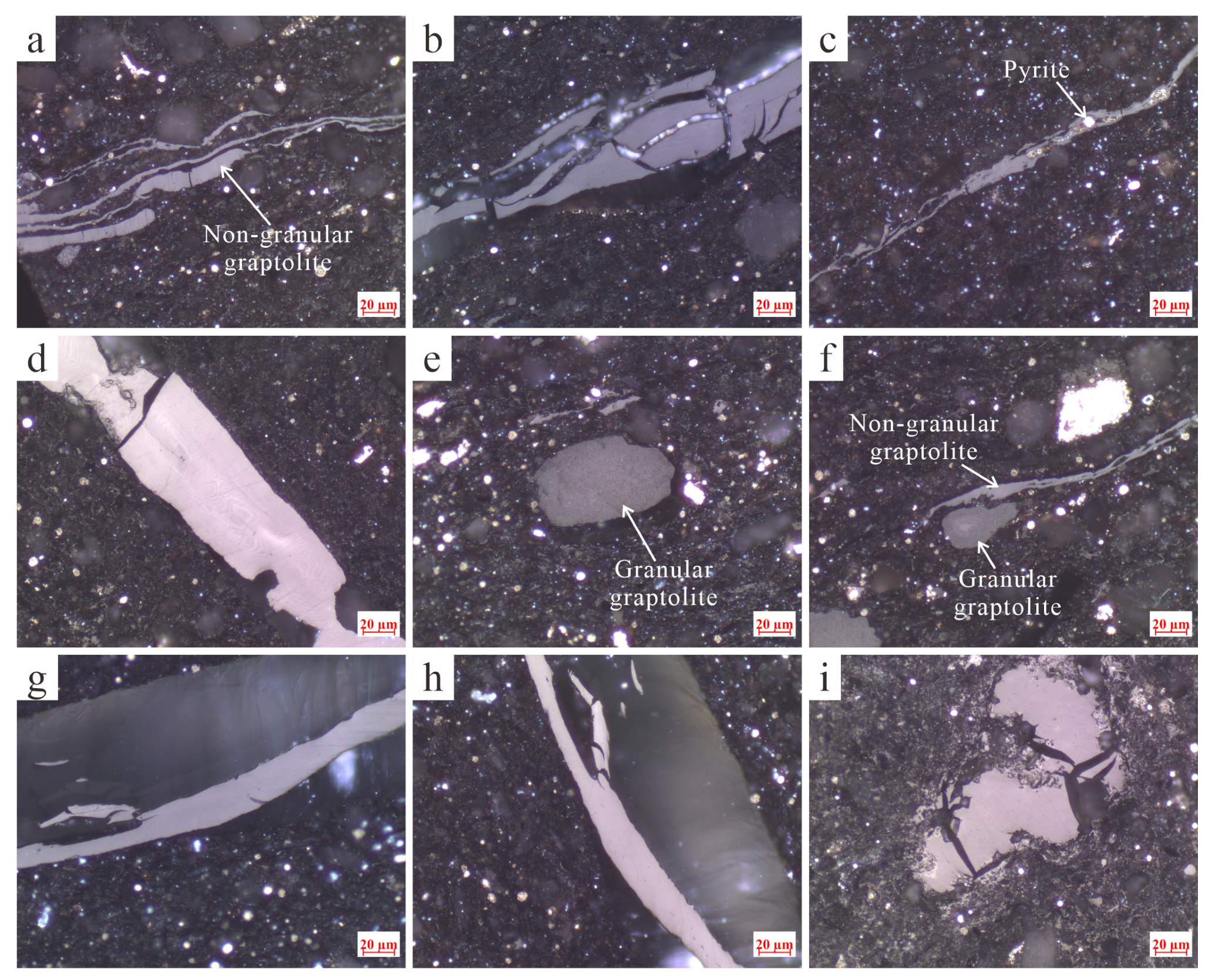
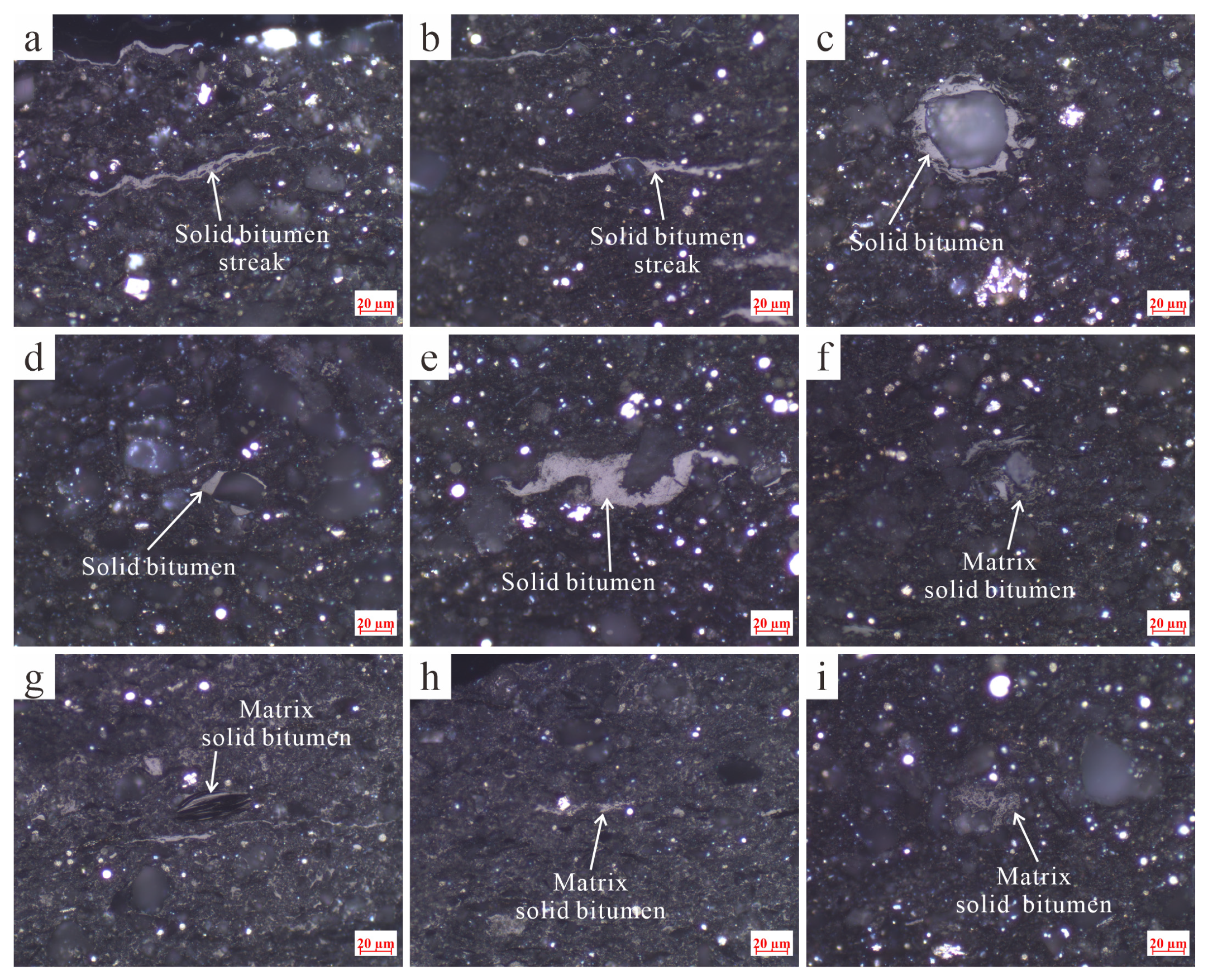
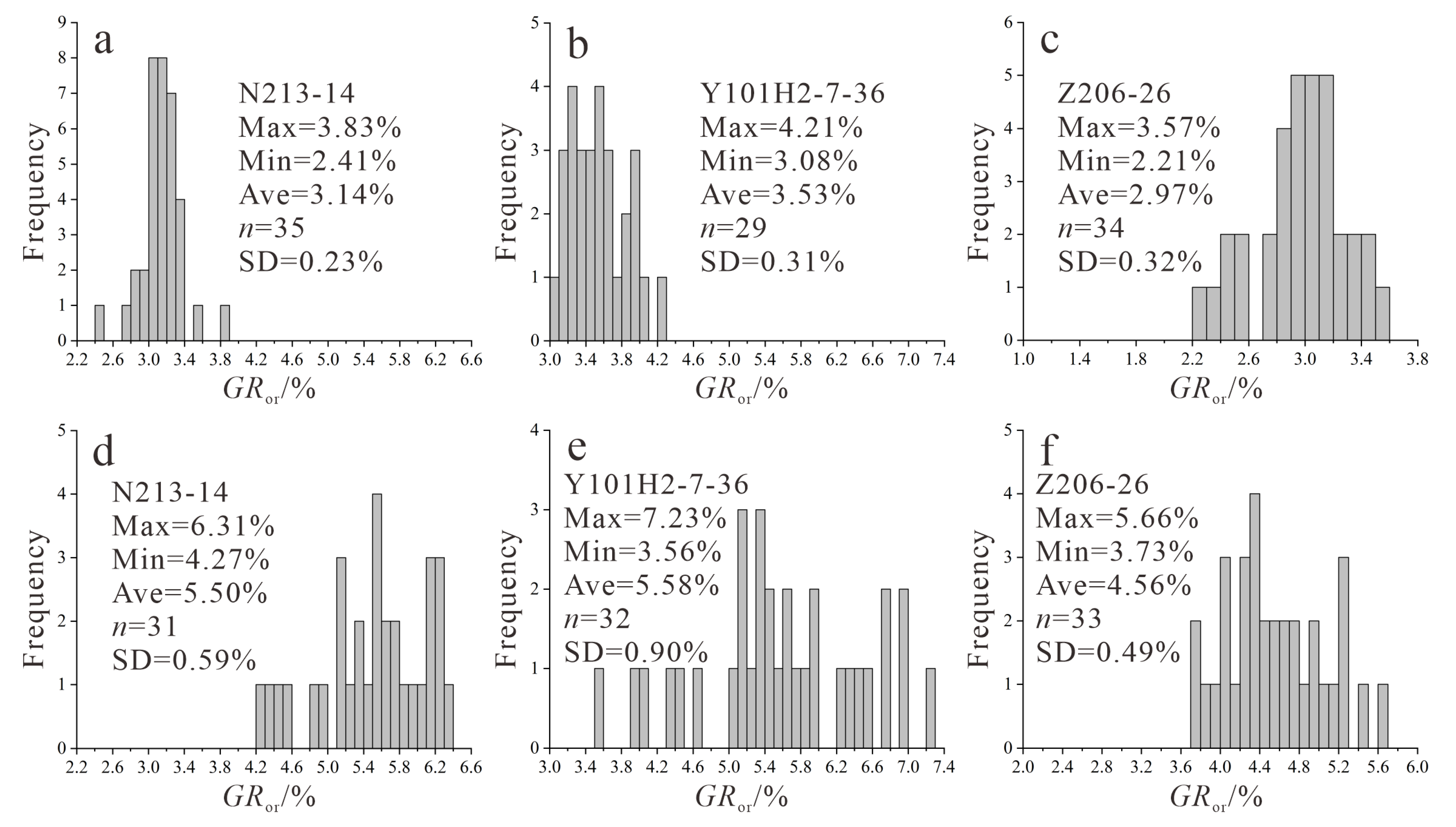

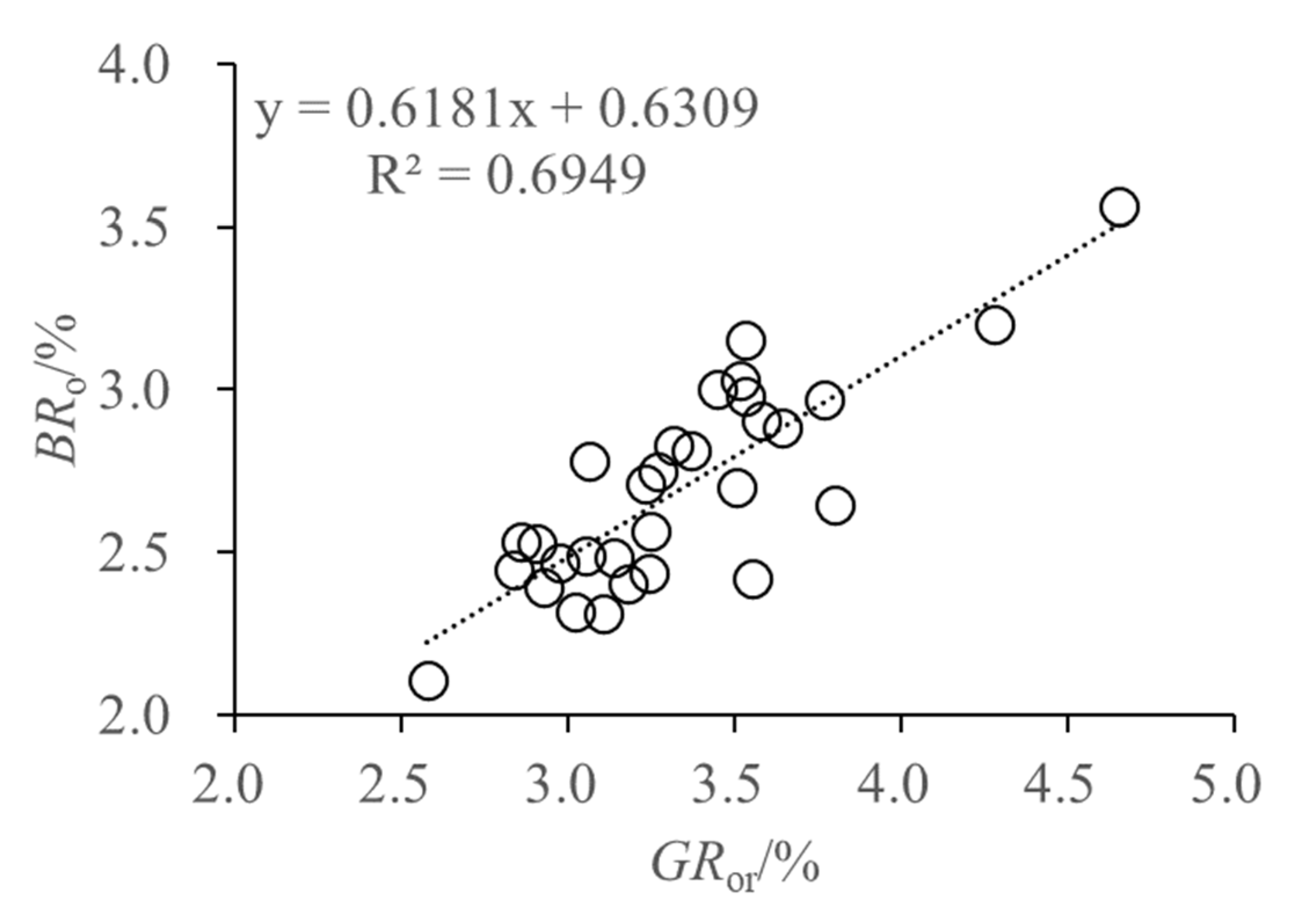
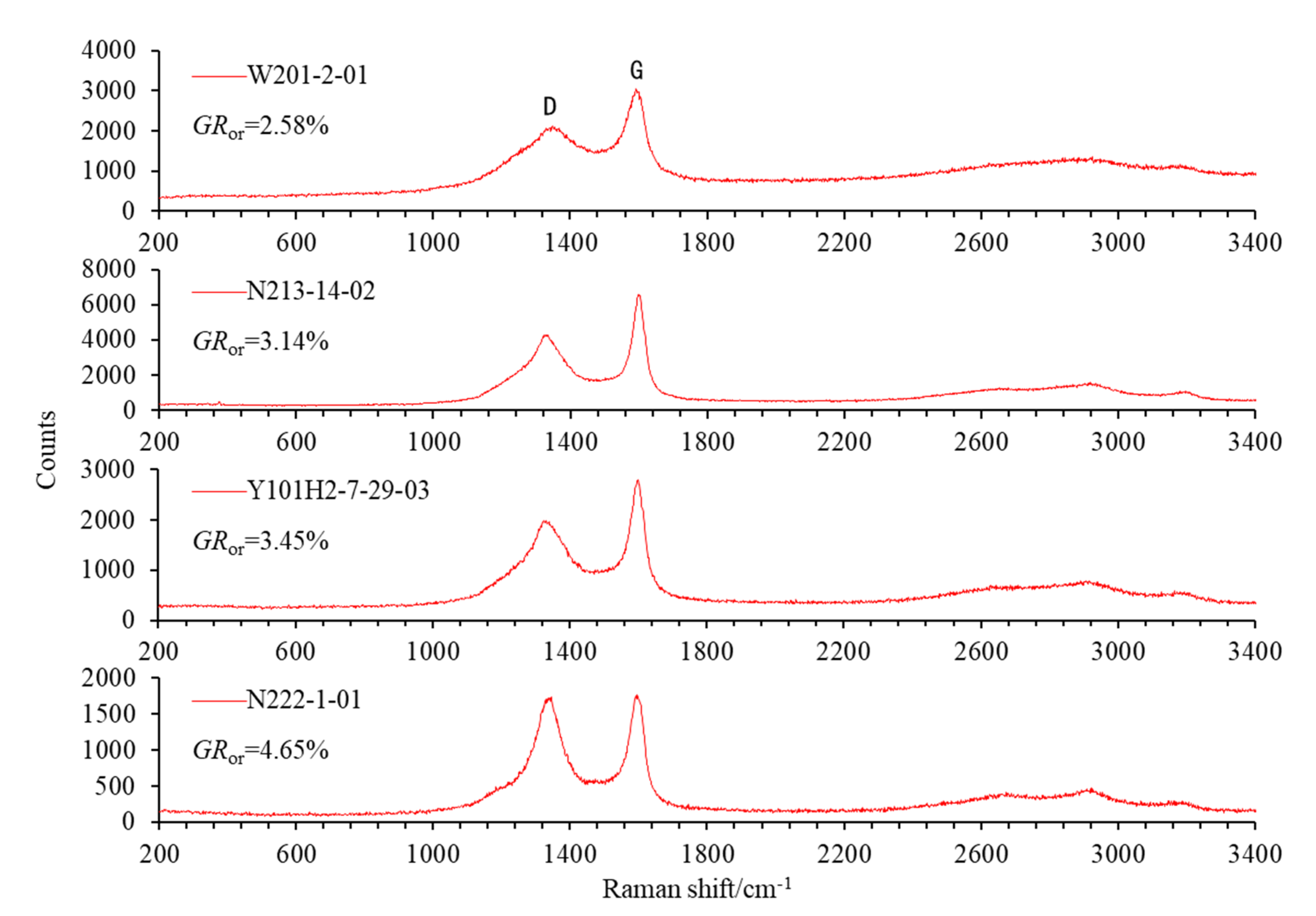
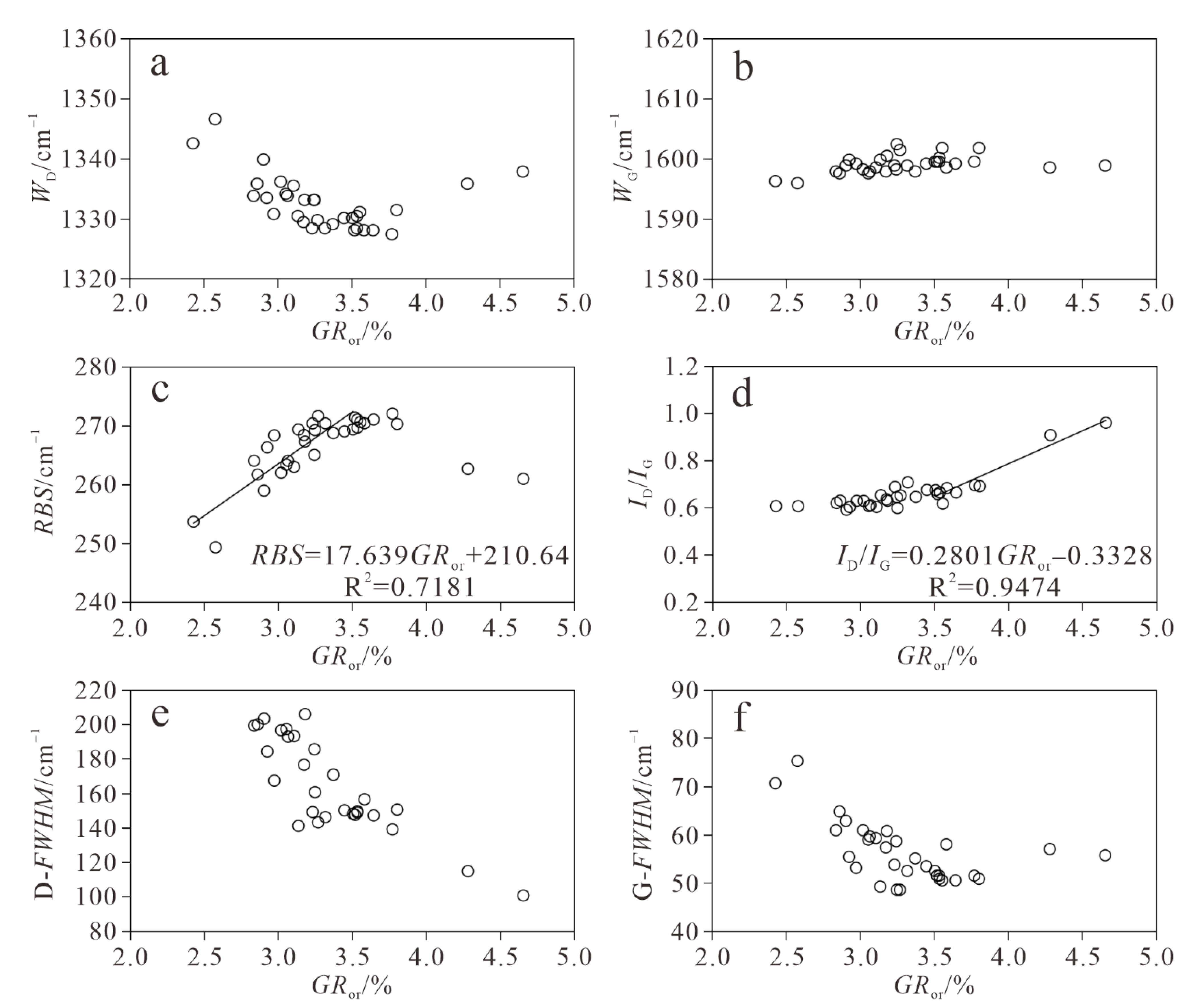
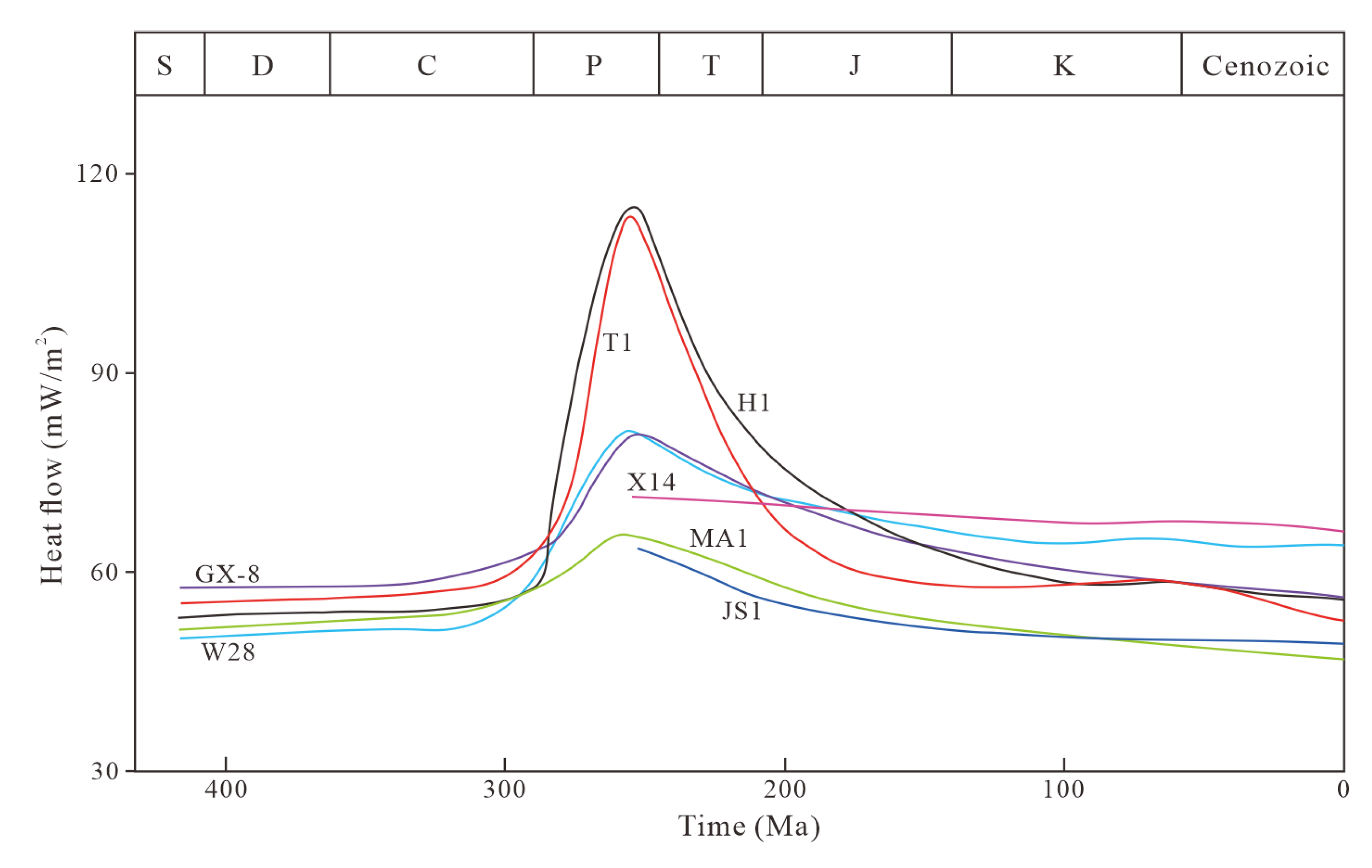

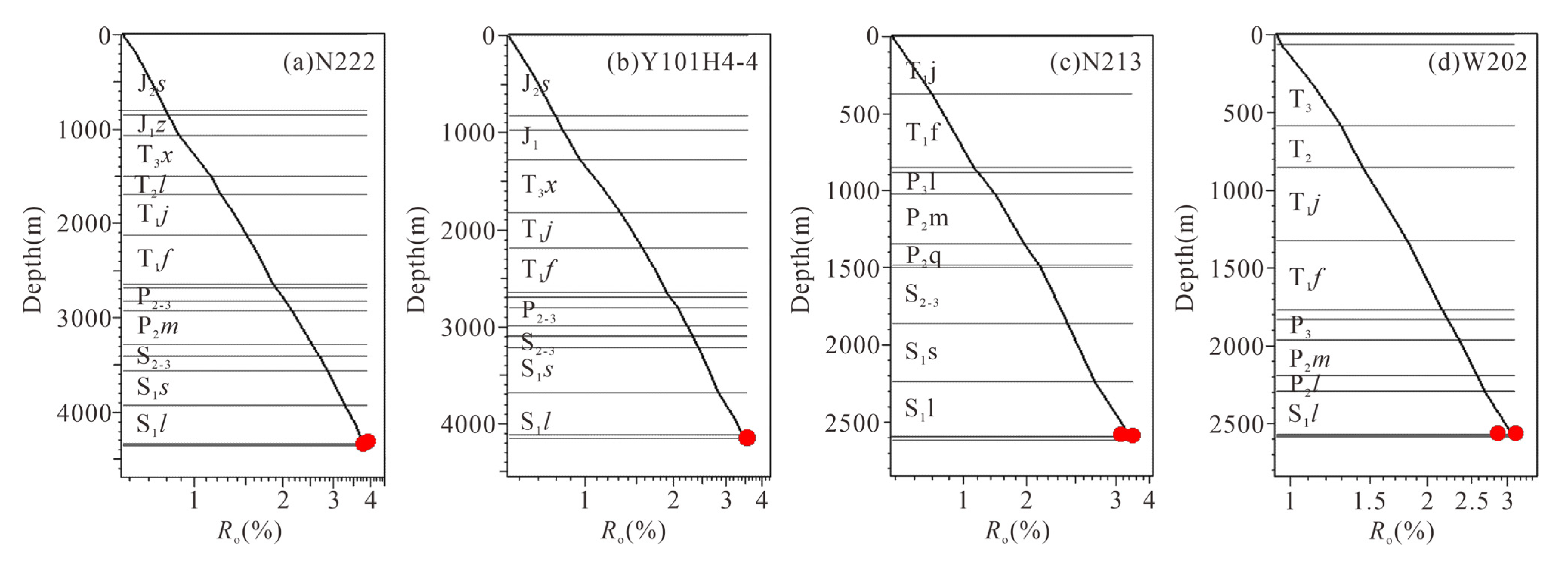

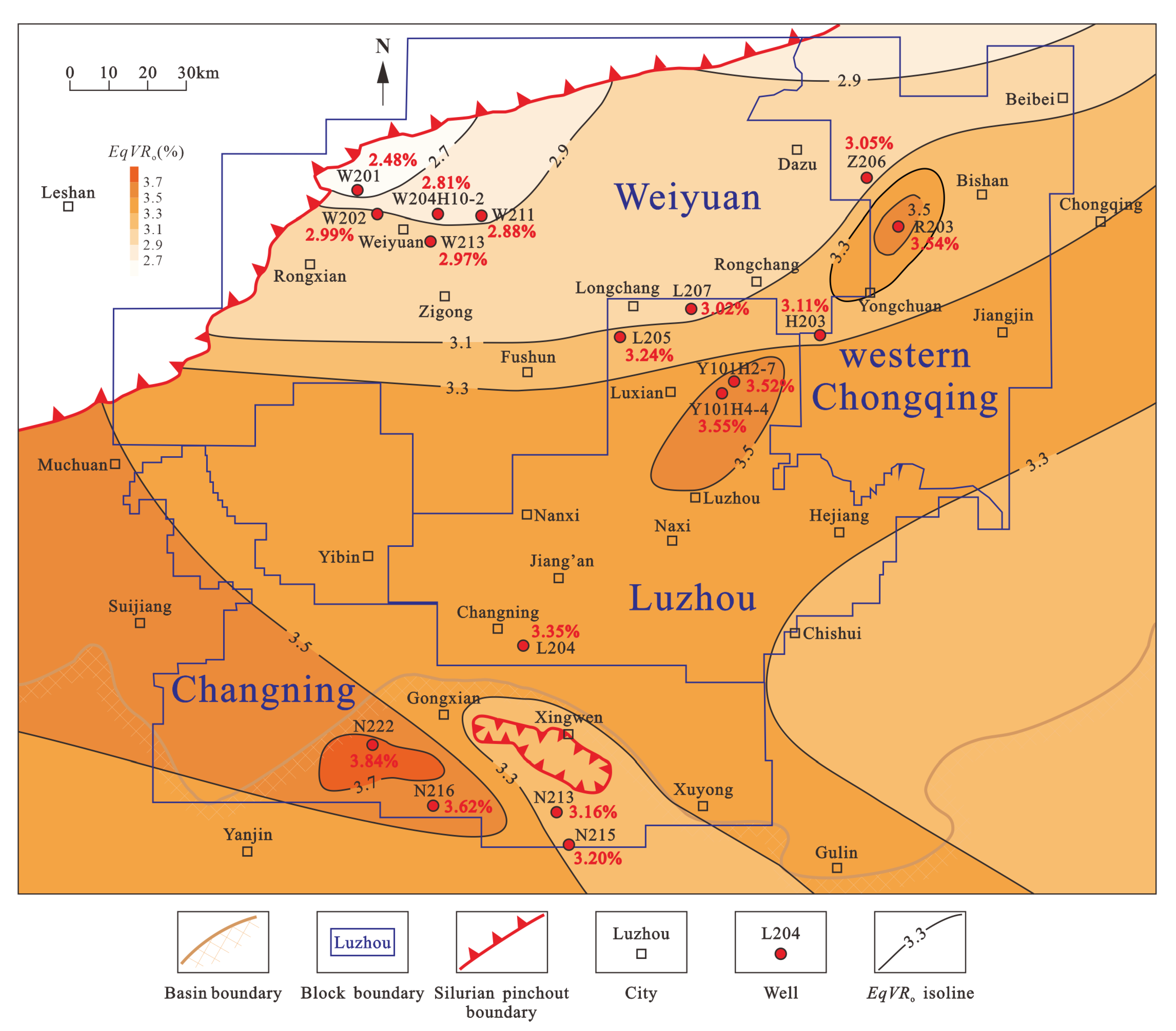

| Sample | Depth (m) | Formation | Perpendicular | GRor (Parallel, %) | BRo | EqVRo-1 (%) | EqVRo-2 (%) | EqVRo-3 (%) | EqVRo-4 (%) | RmcRo (%) | EqVRo-5 (%) | ||||
|---|---|---|---|---|---|---|---|---|---|---|---|---|---|---|---|
| GRor (%) | SD | n | Type A (%) | SD | n | ||||||||||
| Y101H4-4-30 | 4131.55 | Long114 | 3.52 | 0.41 | 18 | 3.03 | 0.38 | 29 | 3.56 | 3.32 | 2.38 | 3.22 | 3.53 | 3.53 | |
| Y101H4-4-44 | 4140.22 | Long113 | 3.58 | 0.29 | 21 | 5.49 | 2.91 | 0.28 | 15 | 3.63 | 3.34 | 2.29 | 3.06 | 3.56 | 3.55 |
| Y101H4-4-52 | 4144.14 | Long112 | 3.64 | 0.36 | 22 | 2.88 | 0.29 | 12 | 3.69 | 3.35 | 2.28 | 3.03 | 3.53 | 3.57 | |
| Y101H4-4-68 | 4150.6 | Wufeng | 3.53 | 0.23 | 34 | 2.98 | 0.52 | 11 | 3.58 | 3.33 | 2.34 | 3.15 | 3.53 | 3.54 | |
| Y101H2-7-29 | 4139.05 | Long113 | 3.45 | 0.33 | 33 | 3.00 | 0.13 | 12 | 3.49 | 3.14 | 2.36 | 3.18 | 3.24 | 3.37 | |
| Y101H2-7-36 | 4146.67 | Long111 | 3.53 | 0.31 | 29 | 5.58 | 3.15 | 0.37 | 15 | 3.58 | 3.33 | 2.46 | 3.38 | 3.53 | 3.54 |
| Z206-7 | 4244.57 | Long114 | 3.24 | 0.15 | 18 | 2.43 | 0.30 | 20 | 3.29 | 2.95 | 1.97 | 2.45 | 3.02 | 3.18 | |
| Z206-26 | 4266.76 | Long111 | 2.97 | 0.32 | 34 | 4.56 | 2.47 | 0.38 | 38 | 3.02 | 2.68 | 2.00 | 2.50 | 3.20 | 2.92 |
| Z206-38 | 4274.36 | Wufeng | 3.22 | ||||||||||||
| L204-17 | 3824.3 | Long113 | 3.23 | 0.30 | 35 | 2.71 | 0.52 | 31 | 3.28 | 2.93 | 2.16 | 2.80 | 3.31 | 3.17 | |
| L204-34 | 3842.21 | Long111 | 3.50 | 0.25 | 16 | 5.49 | 2.70 | 0.26 | 15 | 3.55 | 3.32 | 2.15 | 2.79 | 3.55 | 3.53 |
| L205-20 | 4024.08 | Long113 | 3.25 | 0.14 | 15 | 2.57 | 0.42 | 15 | 3.29 | 2.95 | 2.06 | 2.62 | 3.25 | 3.18 | |
| L205-26 | 4034.44 | Wufeng | 3.37 | 0.10 | 17 | 4.57 | 2.81 | 0.28 | 14 | 3.42 | 3.07 | 2.23 | 2.94 | 3.22 | 3.30 |
| L207-30 | 3448.05 | Long114 | 3.11 | 0.06 | 3 | 2.31 | 0.47 | 32 | 3.15 | 2.81 | 1.89 | 2.30 | 2.91 | 3.05 | |
| L207-32 | 3450.92 | Long113 | 3.05 | 0.13 | 33 | 3.46 | 2.49 | 0.34 | 29 | 3.10 | 2.76 | 2.01 | 2.52 | 2.93 | 3.00 |
| L207-36 | 3457.41 | Wufeng | 3.07 | 0.15 | 11 | 2.78 | 0.17 | 5 | 3.11 | 2.77 | 2.21 | 2.90 | 2.97 | 3.01 | |
| N213-14 | 2575.28 | Long112 | 3.14 | 0.23 | 35 | 5.50 | 2.48 | 0.55 | 3 | 3.18 | 2.84 | 2.01 | 2.51 | 3.26 | 3.08 |
| N213-17 | 2579.22 | Wufeng | 3.32 | 0.27 | 29 | 2.83 | 0.49 | 18 | 3.36 | 3.02 | 2.24 | 2.96 | 3.31 | 3.25 | |
| N216-7 | 2311.78 | Long113 | 3.77 | 0.17 | 31 | 2.97 | 0.33 | 21 | 3.81 | 3.38 | 2.34 | 3.14 | 3.57 | 3.61 | |
| N216-10 | 2320.68 | Long111 | 3.80 | 0.13 | 24 | 4.97 | 2.65 | 0.43 | 11 | 3.84 | 3.39 | 2.12 | 2.72 | 3.56 | 3.62 |
| W204H10-2-15 | 3350.6 | Long112 | 2.84 | 0.25 | 33 | 2.45 | 0.30 | 18 | 2.89 | 2.55 | 1.98 | 2.47 | 2.97 | 2.79 | |
| W204H10-2-23 | 3355.3 | Long111 | 2.86 | 0.15 | 30 | 2.53 | 0.29 | 31 | 2.91 | 2.57 | 2.04 | 2.58 | 2.84 | 2.82 | |
| H203-4 | 3758.1 | Wufeng | 3.17 | 0.22 | 9 | 3.22 | 2.88 | 3.21 | 3.11 | ||||||
| W201-2 | 1541 | Long111 | 2.58 | 0.25 | 27 | 2.88 | 2.11 | 0.27 | 11 | 2.63 | 2.30 | 1.75 | 2.05 | 2.18 | 2.55 |
| W201-3 | 1548.8 | Wufeng | 2.43 | 0.25 | 4 | 2.48 | 2.15 | 2.41 | 2.41 | ||||||
| W202-1 | 2561.5 | Long11 | 3.18 | 0.22 | 35 | 2.40 | 0.35 | 11 | 3.23 | 2.88 | 1.95 | 2.42 | 3.15 | 3.12 | |
| W202-2 | 2568.2 | Long11 | 2.90 | 0.18 | 33 | 2.53 | 0.41 | 14 | 2.95 | 2.62 | 2.04 | 2.57 | 2.70 | 2.86 | |
| W213-1 | 3745.34 | Long11 | 3.02 | 0.22 | 35 | 2.32 | 0.44 | 26 | 3.07 | 2.73 | 1.89 | 2.31 | 2.86 | 2.97 | |
| W211-2 | 3559.5 | Long11 | 2.93 | 0.26 | 26 | 2.39 | 0.45 | 12 | 2.98 | 2.64 | 1.94 | 2.40 | 3.09 | 2.88 | |
| N222-1 | 4301.6 | Long11 | 4.65 | 0.59 | 24 | 3.56 | 0.49 | 8 | 4.69 | 3.57 | 2.74 | 3.94 | 3.88 | 3.91 | |
| N222-4 | 4327.14 | Long11 | 4.28 | 0.29 | 16 | 3.96 | 3.20 | 0.40 | 18 | 4.32 | 3.49 | 2.49 | 3.45 | 3.82 | 3.78 |
| N215-1 | 2502.95 | Long11 | 3.27 | 0.36 | 31 | 2.75 | 0.36 | 19 | 3.32 | 2.97 | 2.19 | 2.85 | 3.38 | 3.20 | |
| R203-1 | 4336.14 | Long11 | 3.55 | 0.44 | 23 | 2.42 | 0.33 | 22 | 3.60 | 3.33 | 1.96 | 2.43 | 3.48 | 3.54 | |
| Sample | GRor (%) | WG (cm−1) | WD (cm−1) | RBS (cm−1) | ID/IG | D-FWHM (cm−1) | G-FWHM (cm−1) |
|---|---|---|---|---|---|---|---|
| Y101H4-4-30 | 3.52 | 1599.54 | 1328.13 | 271.41 | 0.66 | 147.70 | 51.55 |
| Y101H4-4-44 | 3.58 | 1598.57 | 1328.13 | 270.44 | 0.68 | 156.71 | 58.05 |
| Y101H4-4-52 | 3.64 | 1599.21 | 1328.13 | 271.08 | 0.66 | 147.39 | 50.57 |
| Y101H4-4-68 | 3.53 | 1599.54 | 1328.47 | 271.07 | 0.66 | 149.05 | 51.55 |
| Y101H2-7-29 | 3.45 | 1599.21 | 1330.15 | 269.06 | 0.68 | 150.35 | 53.50 |
| Y101H2-7-36 | 3.53 | 1600.19 | 1330.49 | 269.70 | 0.66 | 149.77 | 50.90 |
| Z206-7 | 3.24 | 1598.24 | 1333.18 | 265.06 | 0.64 | 185.68 | 58.70 |
| Z206-26 | 2.97 | 1599.21 | 1330.82 | 268.39 | 0.63 | 167.60 | 53.18 |
| Z206-38 | 1601.48 | 1332.84 | 268.64 | 0.62 | 155.81 | 49.59 | |
| L204-17 | 3.23 | 1598.89 | 1328.47 | 270.42 | 0.69 | 149.35 | 53.82 |
| L204-34 | 3.50 | 1599.54 | 1330.15 | 269.39 | 0.67 | 148.37 | 52.53 |
| L205-20 | 3.25 | 1602.45 | 1333.18 | 269.28 | 0.60 | 160.88 | 48.61 |
| L205-26 | 3.37 | 1597.92 | 1329.14 | 268.78 | 0.65 | 170.95 | 55.13 |
| L207-30 | 3.11 | 1598.57 | 1335.53 | 263.03 | 0.60 | 193.35 | 59.35 |
| L207-32 | 3.05 | 1597.59 | 1334.19 | 263.41 | 0.61 | 197.42 | 59.04 |
| L207-36 | 3.07 | 1597.92 | 1333.85 | 264.07 | 0.61 | 193.00 | 59.68 |
| N213-14 | 3.14 | 1599.86 | 1330.49 | 269.38 | 0.65 | 141.31 | 49.27 |
| N213-17 | 3.32 | 1598.89 | 1328.47 | 270.42 | 0.71 | 146.37 | 52.53 |
| N216-7 | 3.77 | 1599.54 | 1327.46 | 272.08 | 0.70 | 139.27 | 51.55 |
| N216-10 | 3.80 | 1601.81 | 1331.50 | 270.31 | 0.69 | 150.74 | 50.89 |
| W204H10-2-15 | 2.84 | 1597.92 | 1333.85 | 264.07 | 0.62 | 199.43 | 60.98 |
| W204H10-2-23 | 2.86 | 1597.59 | 1335.87 | 261.73 | 0.63 | 200.11 | 64.89 |
| H203-4 | 3.17 | 1597.92 | 1329.48 | 268.44 | 0.64 | 176.66 | 57.41 |
| W201-2 | 2.58 | 1595.97 | 1346.62 | 249.36 | 0.61 | 75.31 | |
| W201-3 | 2.43 | 1596.30 | 1342.59 | 253.71 | 0.61 | 70.74 | |
| W202-1 | 3.18 | 1600.51 | 1333.18 | 267.33 | 0.63 | 206.09 | 60.82 |
| W202-2 | 2.90 | 1598.89 | 1339.90 | 258.99 | 0.59 | 203.46 | 62.93 |
| W213-1 | 3.02 | 1598.24 | 1336.21 | 262.04 | 0.63 | 196.70 | 60.98 |
| W211-2 | 2.93 | 1599.86 | 1333.52 | 266.35 | 0.60 | 184.37 | 55.45 |
| N222-1 | 4.65 | 1598.89 | 1337.89 | 261.01 | 0.96 | 100.83 | 55.77 |
| N222-4 | 4.28 | 1598.57 | 1335.87 | 262.70 | 0.91 | 114.98 | 57.08 |
| N215-1 | 3.27 | 1601.48 | 1329.81 | 271.67 | 0.65 | 143.34 | 48.62 |
| R203-1 | 3.55 | 1601.81 | 1331.16 | 270.65 | 0.62 | 159.81 | 50.57 |
| Sample | Depth (m) | EqVRo (%) | T1 (°C) | Mean Value of T1 (°C) | T2 (°C) |
|---|---|---|---|---|---|
| Y101H4-4-30 | 4131.55 | 3.53 | 237.22 | 237.60 | 230.37 |
| Y101H4-4-44 | 4140.22 | 3.55 | 237.70 | ||
| Y101H4-4-52 | 4144.14 | 3.57 | 238.16 | ||
| Y101H4-4-68 | 4150.60 | 3.54 | 237.34 | ||
| L207-30 | 3448.05 | 3.05 | 225.43 | 224.65 | 215.48 |
| L207-32 | 3450.92 | 3.00 | 224.12 | ||
| L207-36 | 3457.41 | 3.01 | 224.40 | ||
| Z206-7 | 4244.57 | 3.18 | 228.80 | 225.40 | 224.20 |
| Z206-26 | 4266.76 | 2.92 | 222.00 | ||
| N213-14 | 2575.28 | 3.08 | 226.16 | 228.36 | 223.96 |
| N213-17 | 2579.22 | 3.25 | 230.57 | ||
| N216-7 | 2311.78 | 3.61 | 239.10 | 239.22 | 239.88 |
| N216-10 | 2320.68 | 3.62 | 239.34 | ||
| N222-1 | 4301.60 | 3.91 | 245.36 | 244.08 | 244.70 |
| N222-4 | 4327.14 | 3.78 | 242.79 | ||
| W202-1 | 2561.50 | 3.12 | 227.27 | 223.72 | 214.20 |
| W202-2 | 2568.20 | 2.86 | 220.17 |
Publisher’s Note: MDPI stays neutral with regard to jurisdictional claims in published maps and institutional affiliations. |
© 2022 by the authors. Licensee MDPI, Basel, Switzerland. This article is an open access article distributed under the terms and conditions of the Creative Commons Attribution (CC BY) license (https://creativecommons.org/licenses/by/4.0/).
Share and Cite
Lyu, P.; Meng, J.; Pan, R.; Yi, X.; Yue, T.; Zhang, N. Characteristics and Differences Analysis for Thermal Evolution of Wufeng–Longmaxi Shale, Southern Sichuan Basin, SW China. Minerals 2022, 12, 906. https://doi.org/10.3390/min12070906
Lyu P, Meng J, Pan R, Yi X, Yue T, Zhang N. Characteristics and Differences Analysis for Thermal Evolution of Wufeng–Longmaxi Shale, Southern Sichuan Basin, SW China. Minerals. 2022; 12(7):906. https://doi.org/10.3390/min12070906
Chicago/Turabian StyleLyu, Peixi, Jianghui Meng, Renfang Pan, Xuefei Yi, Tao Yue, and Ning Zhang. 2022. "Characteristics and Differences Analysis for Thermal Evolution of Wufeng–Longmaxi Shale, Southern Sichuan Basin, SW China" Minerals 12, no. 7: 906. https://doi.org/10.3390/min12070906
APA StyleLyu, P., Meng, J., Pan, R., Yi, X., Yue, T., & Zhang, N. (2022). Characteristics and Differences Analysis for Thermal Evolution of Wufeng–Longmaxi Shale, Southern Sichuan Basin, SW China. Minerals, 12(7), 906. https://doi.org/10.3390/min12070906







